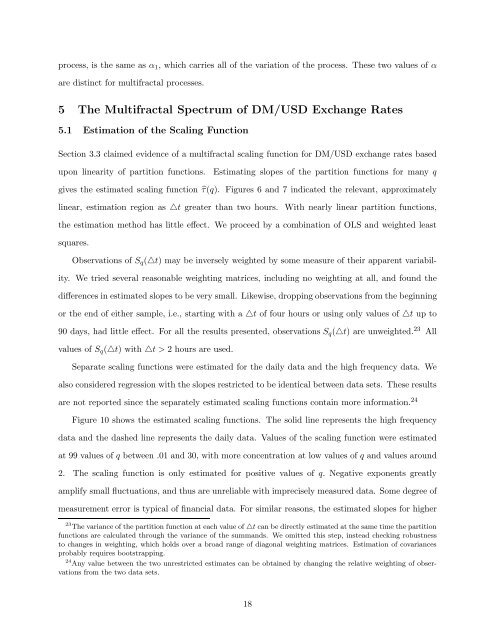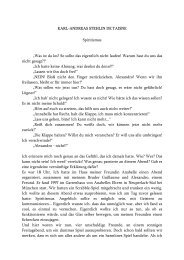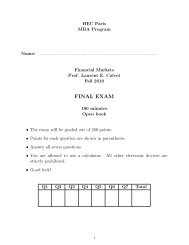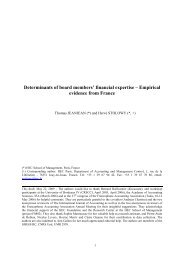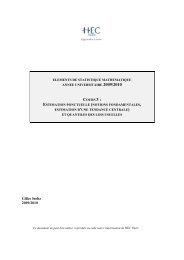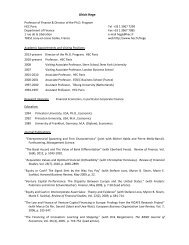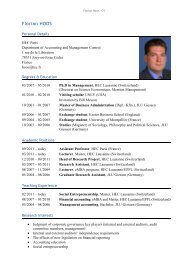Multifractality of US Dollar/Deutsche Mark Exchange Rates - Studies2
Multifractality of US Dollar/Deutsche Mark Exchange Rates - Studies2
Multifractality of US Dollar/Deutsche Mark Exchange Rates - Studies2
Create successful ePaper yourself
Turn your PDF publications into a flip-book with our unique Google optimized e-Paper software.
process, is the same as α1, which carries all <strong>of</strong> the variation <strong>of</strong> the process. These two values <strong>of</strong> α<br />
are distinct for multifractal processes.<br />
5 The Multifractal Spectrum <strong>of</strong> DM/<strong>US</strong>D <strong>Exchange</strong> <strong>Rates</strong><br />
5.1 Estimation <strong>of</strong> the Scaling Function<br />
Section 3.3 claimed evidence <strong>of</strong> a multifractal scaling function for DM/<strong>US</strong>D exchange rates based<br />
upon linearity <strong>of</strong> partition functions. Estimating slopes <strong>of</strong> the partition functions for many q<br />
gives the estimated scaling function τ(q). Figures 6 and 7 indicated the relevant, approximately<br />
linear, estimation region as △t greater than two hours. With nearly linear partition functions,<br />
the estimation method has little effect. We proceed by a combination <strong>of</strong> OLS and weighted least<br />
squares.<br />
Observations <strong>of</strong> Sq(△t) may be inversely weighted by some measure <strong>of</strong> their apparent variabil-<br />
ity. We tried several reasonable weighting matrices, including no weighting at all, and found the<br />
differences in estimated slopes to be very small. Likewise, dropping observations from the beginning<br />
or the end <strong>of</strong> either sample, i.e., starting with a △t <strong>of</strong> four hours or using only values <strong>of</strong> △t up to<br />
90 days, had little effect. For all the results presented, observations Sq(△t) are unweighted. 23 All<br />
values <strong>of</strong> Sq(△t) with△t >2 hours are used.<br />
Separate scaling functions were estimated for the daily data and the high frequency data. We<br />
also considered regression with the slopes restricted to be identical between data sets. These results<br />
are not reported since the separately estimated scaling functions contain more information. 24<br />
Figure 10 shows the estimated scaling functions. The solid line represents the high frequency<br />
data and the dashed line represents the daily data. Values <strong>of</strong> the scaling function were estimated<br />
at 99 values <strong>of</strong> q between .01 and 30, with more concentration at low values <strong>of</strong> q and values around<br />
2. The scaling function is only estimated for positive values <strong>of</strong> q. Negative exponents greatly<br />
amplify small fluctuations, and thus are unreliable with imprecisely measured data. Some degree <strong>of</strong><br />
measurement error is typical <strong>of</strong> financial data. For similar reasons, the estimated slopes for higher<br />
23<br />
The variance <strong>of</strong> the partition function at each value <strong>of</strong> △t can be directly estimated at the same time the partition<br />
functions are calculated through the variance <strong>of</strong> the summands. We omitted this step, instead checking robustness<br />
to changes in weighting, which holds over a broad range <strong>of</strong> diagonal weighting matrices. Estimation <strong>of</strong> covariances<br />
probably requires bootstrapping.<br />
24<br />
Any value between the two unrestricted estimates can be obtained by changing the relative weighting <strong>of</strong> observations<br />
from the two data sets.<br />
18


